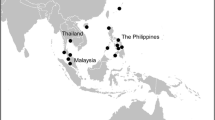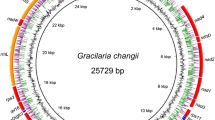Abstract
Mitochondrial cytochrome c oxidase subunit I (cox1) was employed to investigate the intraspecific genetic diversity of Gracilaria changii collected from various localities distributed along the west coast of Peninsular Malaysia. Gracilaria changii is an agarophyte with potential for commercialization in Malaysia as it has high yields of good quality agar with high gel strength for the production of food grade agar and agarose. The phylogeographic aspect of G. changii has not been studied despite its abundance and potential commercialization. In this study, six mitochondrial haplotypes (C1–C6) were revealed from 62 specimens varying by 0–3 bp over 923 bp. Results indicate that haplotype C1 is the common ancestor and the most widespread haplotype due to its prevalence in Morib, Gua Tanah, Middle Banks, Batu Besar, Batu Tengah, Sungai Pulai, and Kuala Sungai Merbok. In this study, Morib was suggested as contributing the highest intra-population diversity with the identification of three haplotypes. The mitochondrial marker cox1 is a highly divergent mitochondrial marker and is applicable for studies on species identification and assessment of genetic diversity of G. changii.


Similar content being viewed by others
References
Avise JC (1994) Molecular markers, natural history and evolution. Chapman & Hall, New York, 511 pp
Bellorin AM, Oliveira MC, Oliveira EC (2002) Phylogeny and systematics of the marine algal family Gracilariaceae (Gracilariales, Rhodophyta) based on SSU rDNA and ITS sequences of Atlantic and Pacific species. J Phycol 38:551–563
Bird CJ, Mclachlan J (1982) Some underutilized taxonomic criteria in Gracilaria (Rhodophyta, Gigartinales). Bot Mar 25:557–562
Boudouresque CF, Verlaque M (2002) Biological pollution in the Mediterranean Sea: invasive versus introduced macrophytes. Mar Pollut Bull 44:32–38
Brodie J, Zuccarello GC (2007) Systematics of the species-rich algae: red algal classification, phylogeny and speciation. In: Hodkinson TR, Parnell JAN (eds) Reconstructing the tree of life: taxonomy and systematic of species rich taxa. Systematics Association Special Volume Series 72. CRC, Boca Raton, pp 323–336
Buschmann AH, Correa JA, Westermeier R, Hernandez-Gonzalez MC, Norambuena R (2001) Red algal farming in Chile. Aquaculture 194:203–220
Byrne K, Zuccarello GC, West J, Liao ML, Kraft GT (2002) Gracilaria species (Gracilariaceae, Rhodophyta) from southeastern Australia, including a new species, Gracilaria perplexa sp. nov.: morphology, molecular relationships and agar content. Phycological Research 50:295–312
Carlton JT, Hodder J (1995) Biogeography and dispersal of coastal marine organism—experimental studies on replica of 16th century sailing vessel. Mar Biol 121:721–730
Cho GY, Kogame K, Kawaii H, Boo SM (2007) Genetic diversity of Scytosiphon lomentaria (Scytosiphonaceae, Phaeophyceae) from the Pacific and Europe based on RuBisCo large subunit and spacer, and ITS nrDNA sequences. Phycologia 46:657–665
Chu WL, Norazmi M, Phang SM (2003) Fatty acid composition of some Malaysian seaweeds. Malaysian Journal of Science 22:21–27
Clement M, Posada D, Crandall KA (2000) TCS: a computer program to estimate gene genealogies. Mol Ecol 9:1657–1659
Coyer JA, Hoarau G, Stam WT, Olsen JL (2004) Geographically specific heteroplasmy of mitochondrial DNA in the seaweed, Fucus serratus (Heterokontophyta, Phaeophyceae, Fucales). Mol Ecol 13:1323–1326
Curiel D, Bellemo G, Marzocchi M, Scattolin M, Parisi G (1998) Distribution of the introduced Japanese macroalgae Undaria pinnatifida, Sargassum muticum (Phaeophyta) and Antithamnion pectinatum (Rhodophyta) in the Lagoon of Venice. Hydrobiologia 385:17–22
Farnham WF (1994) Introduction of marine benthic algae into Atlantic Europe waters. In: Boudouresque CF, Briad F, Nolan C (eds) Introduced species in European coastal waters. Europe Commission, Luxemburg, pp 32–36
Farnham WF, Fletcher RF, Irvine RL (1973) Atlantic Sargassum found in Britain. Nature 243:231–232
Fletcher RL, Farrell P (1999) Introduced brown algae in the north east Atlantic, with particular reference to Undaria pinnatifida (Harvey) Suringar. Helgoländer Meeresuntersuch 52:259–275
Gan SY, Qin S, Rofina YO, Yu D, Phang SM (2003) Transient expression of lacZ in particle bombarded Gracilaria changii (Gracilariaceae, Rhodophyta). J Appl Phycol 15:351–353
Geraldino PJL, Yang EC, Boo SM (2006) Morphology and molecular phylogeny of Hypnea flexicaulis (Gigatinales, Rhodophyta) from Korea. Algae 21:417–423
Gurgel CFD, Fredericq S (2004) Systematics of Gracilariaceae (Gracilariales, Rhodophyata): a critical assessment based on rbcL sequence analyses. J Phycol 40:138–159
Hall TA (1999) BioEdit: a user-friendly biological sequence aligment editor and analysis program for Windows 95/98/NT. Nucleic Acids Symp Ser 41:95–98
Hayden HS, Blomster J, Maggs CA, Silva PC, Stanhope MJ, Waaland JR (2003) Linnaeus was right all along: Ulva and Enteromorpha are not distinct genera. Eur J Phycol 38:277–294
Ho CL, Teoh S, Teo SS, Raha AR, Phang SM (2009) Profiling the transcriptome of Gracilaria changii (Rhodophyta) in response to light deprivation. Mar Biotechnol 11:1436–2236
Hughes AR, Inouye BD, Johnson MTJ, Underwood N, Vellend M (2008) Ecological consequences of genetic diversity. Ecol Lett 11:609–623
Kim HS, Hwang IK, Lee WJ (2004) Evidence for taxonomic status of Pachydictyon coriaceum (Holmes) Okamura (Dictyotales, Phaeophyceae) based on morphology and plastid protein encoding rbcL, psaA and psbA gene sequences. Algae 19:175–190
Lee AC, Liao LM, Tan KS (2009) New records of marine algae on artificial structure and intertidal flats in coastal waters of Singapore. Raffles Bull Zool 22:5–40
Lim PE, Phang SM (2004) Gracilaria species (Gracilariales, Rhodophyta) of Malaysia including two new records. Malays J Sci 23:71–80
Marston M, Villalard-Bohnsack M (2002) Genetic variability and potential sources of Grateloupis doryphora (Halymeniaceae, Rhodophyta), an invasive species in Rhode Island waters (USA). J Phycol 38:649–658
McIvor L, Maggs CA, Provan J, Stanhope MJ (2001) rbcL sequences reveal multiple cryptic introductions of the Japanese red alga Polysiphonia harveyi. Mol Ecol 10:911–919
McLachlan J, Bird CJ (1986) Gracilaria (Gigartinales, Rhodophyta) and productivity. Aquat Bot 26:27–49
Mousseau TA, Sinervo B, Endler JA (2000) Adaptive genetic variation in the wild. Oxford University Press, New York
Nam KW, Maggs CA, McIvor L, Stanhope MJ (2000) Taxonomy and phylogeny of Osmunder (Rhodomelaceae, Rhodophyta) in Atlantic. Eur J Phycol 36:759–772
Nelson WA, Maggs CA, McIvor L, Stanhope MJ (1996) Records of adventives marine algae in New Zealand: Antithamnionella ternifolia, Polysiphonia senticulosa (Ceramiales, Rhodophyta) and Striaria attenuate (Dictyosiphonales, Phaeophyta). NZ J Mar Freshw Res 30:449–453
Oliveira EC, Alveal IK, Anderson R (2000) Mariculture of the agar-producing Gracilarioid red algae. Rev Fish Sci 8:345–377
Phang SM (1994) Some species of Gracilaria from Peninsular Malaysia and Singapore. In: Abbott IA (ed) Taxonomy of economic seaweeds with reference to some Pacific and Caribbean species, vol V. California Sea Grant College Publication, La Jolla, pp 125–134
Phang SM (1998) The seaweed resources of Malaysia. In: Critchley AT, Ohno M, Largo DB, Gillespie RD (eds) Seaweed resources of the world. Japan International Cooperation Agency, Yokosuka, pp 79–91
Phang SM, Shaharuddin S, Noraishah H, Sasekumar A (1996) Studies on Gracilaria changii (Gracilariales, Rhodophyta) from Malaysian mangroves. Hydrobiologia 326/327:347–352
Ribera MA, Boudouresque CF (1995) Introduced marine plants, with special reference to macroalgae, mechanisms and impact. Prog Phycol Res 11:187–268
Robba L, Russell SJ, Barker GL, Brodie J (2006) Assessing the use of mitochondrial cox1 marker for use in DNA barcoding of red algae (Rhodophyta). Am J Bot 93:1101–1108
Rueness J (1989) Sargassum muticum and other introduced Japanese macroalgae: biological pollution of European coasts. Mar Pollut Bull 20:173–176
Rueness J (2005) Life history and molecular sequences of Gracilaria vermiculophylla (Gracilariales, Rhodophyta), a new introduction of European waters. Phycology 44:120–128
Rueness J, Rueness EK (2000) Caulacanthus ustulatus (Gigartinales, Rhodophyta) from Brittany (France) is an introduction from the Pacific Ocean. Cryptogamie Algologie 21:355–363
Saunders GW (2005) Applying DNA barcoding to red macroalgae: a preliminary appraisal holds promise for future applications. Philos Trans R Soc 360:1879–1888
Shaffelke B, Smith JE, Hewitt CL (2006) Introduced macroalgae—a growing concern. J Appl Phycol 18:529–541
Sherwood AR (2008) Phylogeography of Asparagopsis taxiformis (Bonnemaisoniales, Rhodophyta) in the Hawaiian Islands: two mtDNA markers support three separate introductions. Phycologia 47:79–88
Smith JE, Hunter CL, Smith CM (2002) Distribution and reproductive characteristics of nonindigenous and invasive marine algae in the Hawaiian Islands. Pac Sci 56:299–315
Steel DJ, Trewick SA, Wallis GP (2000) Heteroplasmy of mitochondrial DNA in the ophiuroid Asterobrachion constricum. J Hered 91:146–149
Swofford DL (2002) PAUP*. Phylogenetic analysis using parsimony (* and other methods), version 4. Sinauer, Sunderland
Teo SS, Ho CL, Teoh S, Lee WW, Tee JM, Raha Abd Rahim, Phang SM (2007) Analyses of expressed sequence tags from an agarophyte, Gracilariales, Rhodophyta. Eur J Phycol 42:41–46
Teo SS, Ho CL, Teoh S, Raha Abd Rahim, Ohang SM (2009) Transcriptomic analysis of Gracilaria changii (Rhodophyta) in response to hyper- and hypoosmotic stresses. J Phycol 45:1093–1099
Thompson JN (1998) Rapid evolution as an ecological process. Trend Ecol Evol 13:329–332
Thompson JD, Gibson TJ, Plewniak F, Jeanmougin F, Higgins DG (1997) The Clustal X windows interface: flexible stratrgies for multiple sequence alignment aided by quality analysis tools. Nucleic Acids Res 24:4876–4882
Umina PA, Weeks AR, Kearney MR, McKechnie SW, Hoffmann AA (2005) A rapid shift in a classic clinal pattern in Drosophila reflecting climate change. Science 308:691–693
Uwai S, Nelson W, Neill K, Wang WD, Aguilar-Ross LE, Boo SM, Kitayama T, Kawaii H (2006a) Genetic diversity in Undaria pinnatifida (Laminariales, Phaeophyceae) deduced from mitochondria genes—origin and succession of introduced populations. Phycologia 45:687–695
Uwai S, Yotsukura N, Serisawa Y, Muraoka D, Hiraoka M, Kogame K (2006b) Intraspecific genetic diversity of Undaria pinnatifida in Japan, based on the mitochondrial of cox3 gene and ITS1 of nrDNA. Hydrobiologia 553:345–356
Vidal R (2008) Phylogeography of the genus Spongites (Corallinales, Rhodophyta) from Chile. J Phycol 44:173–182
Wong PF, Tan LJ, Nawi H, AbuBakar S (2006) Proteomics of the red alga, Gracilaria changii (Gracilariales, Rhodophyta). J Phycol 42:113–120
Wong TK-M, Ho CL, Lee WW, Raha Abd Rahim, Phang SM (2007) Analyses of expressed sequence tags from Sargassum binder (Phaeophyta). J Phycol 43:528–534
Xia BM, Abbott IA (1987) New species of Polycarvernosa Chang and Xia (Gracilariaceae, Rhodophyta) from the western Pacific. Phycologia 26:405–418
Yang EC, Kim MS, Geraldino PJL, Sahoo D, Shin JA, Boo SM (2007) Mitochondrial cox1 and plastid rbcL genes of Gracilaria vermiculophylla (Gracilariaceae, Rhodophyta). J Appl Phycol 20:161–168
Yeong HY, Khalid N, Phang SM (2008) Protoplast isolation and regeneration from Gracilaria changii (Gracilariales, Rhodophyta). J Appl Phycol 20:641–651
Zuccarello GC, West JA (2002) Phylogeography of the Bostrychia calliptera–B. pinnata complex (Rhodomelaceae, Rhodophyta) and divergence rates based on nuclear, mitochondrial and plastid DNA markers. Phycologia 41:49–60
Zuccarello GC, Burger G, West JA, King RJ (1999) A mitochondrial marker for red algal intraspecific relationships. Mol Ecol 8:1443–1447
Zuccarello GC, Buchnan J, West JA (2006a) Increased sampling for inferring phylogeographic patterns in Bostrychia radicans/ B. moritziana (Rhodomelaceae, Rhodophyta) in the eastern USA. J Phycol 42:1349–1352
Zuccarello GC, Critchley AT, Smith J, Sieber V, Lhonneur GB, West JA (2006b) Systematics and genetic variation in commercial Kappaphycus and Eucheuma (Solieriaceae, Rhodophyta). J Appl Phycol 18:643–651
Acknowledgments
This study was supported by Fundamental Research Grant Scheme (FRGS) Grant: Molecular Systematics of Gracilariales and Genetic Diversity of Gracilaria changii (FP 044-2008A), University of Malaya Research Grant Scheme: Genetic Diversity of Gracilaria species (PS 136/2008A and PS 160/2009A), and Forest Research Institute Malaysia (FRIM) Grant: Checklist and Revision of Lower Plants of Malaysia (Marine Algae, no. 20300202030).
Author information
Authors and Affiliations
Corresponding author
Additional information
Paper presented at the 7th Asia Pacific Congress on Algal Biotechnology, New Delhi, 2009.
Rights and permissions
About this article
Cite this article
Yow, YY., Lim, PE. & Phang, SM. Genetic diversity of Gracilaria changii (Gracilariaceae, Rhodophyta) from west coast, Peninsular Malaysia based on mitochondrial cox1 gene analysis. J Appl Phycol 23, 219–226 (2011). https://doi.org/10.1007/s10811-010-9535-5
Received:
Revised:
Accepted:
Published:
Issue Date:
DOI: https://doi.org/10.1007/s10811-010-9535-5




